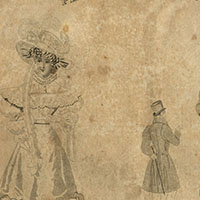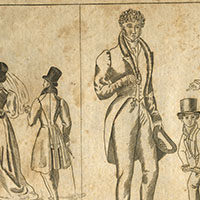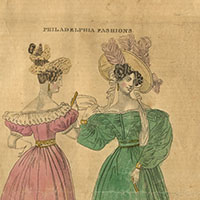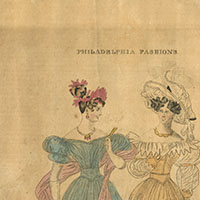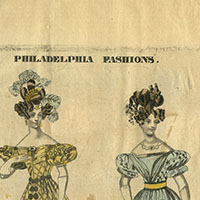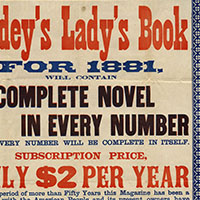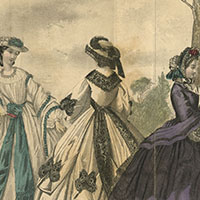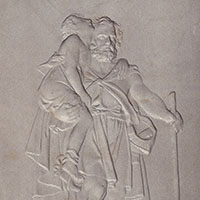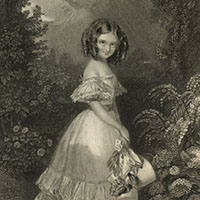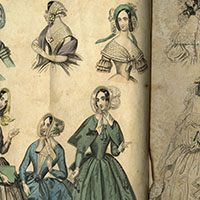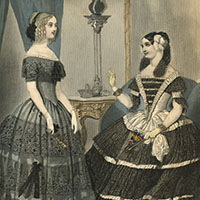In Vogue
The Philadelphia magazine The Souvenir announced these fashion plates with very little fanfare, even though they were some of the first American examples and quite costly to produce. In early images men often appeared alongside women. But over time they migrated to the poster-sized fashion plates that served as style guides for professional tailors, leaving magazine illustrations to showcase women’s fashions alone.
As can be seen here, some of the plates are hand-colored, for which Souvenir subscribers had to pay fifty cents more a year. The plate for spring and summer of 1827 was drawn by merchant tailor Allen Ward, who was the first to patent a system for measuring men’s jackets, in 1821.
Engraved fashion plates from The Souvenir. Philadelphia: Philip Price, Jr., 1827-1830.
Godey’s Lady’s Book was the most popular and long-lived American women’s magazine, lasting from 1830 to 1898; it once had a circulation of over 150,000. Philadelphian Louis A. Godey (1804-1878) was the magazine’s owner, publisher, and founding editor. After Godey hired Sarah Josepha Hale (1788-1879) as his co-editor in 1837, the periodical found its true voice, attracting the most talented writers of the time.
Hale was an unlikely choice for the position. An author in her own right who was single-handedly supporting five children, she believed that women should be educated and able to own property. She even fought Godey about including fashion plates in the magazine, claiming they were frivolous! As seen in the examples here, the publisher won out, and the bright, hand-colored fashion plates became a regular and much anticipated part of the monthly magazine. Godey’s promoted mass consumption in other ways as well, such as slipping product placements into stories.
Hand-colored fashion plates from Godey’s Lady’s Book, May and June, 1863. Courtesy of Wendy Woloson.
In their competitive drive to create the most lavish fashion plates as cheaply as possible, magazine publishers engaged in a printing arms race of sorts, spurring innovations in visual technologies. The plates shown here are but a few examples of the many new kinds of images they introduced to their readers.
The portrait of “Belisarius” was made with a metal lathe invented by Asa Spencer and typically used to create banknotes and stock certificates. Facing that image is a fashion plate printed only in blue. The color print of a bouquet was likely created by the combination of several experimental techniques that are now lost to history.
By the 1840s hand-colored plates were a regular and expected feature of many women’s magazines. In an assembly-line process, women workers hand-tinted the images. When a painter ran out of a color, she simply chose a different one from her palette. But these inconsistencies could cause uncertainty among readers, for whom color was as important as cut when it came to the latest trends.
The black-and-white image in the Lady’s World of Fashion is perhaps the first fashion plate published in America that illustrated wedding dresses.



